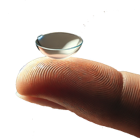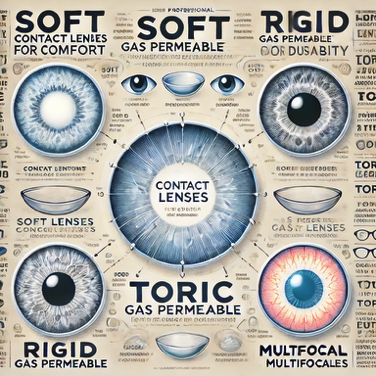Office Hours
Mon-Wed 10am-5pm
Thursday Closed
Friday 10am-5pm
Saturday - 9am-2pm
Contact Lenses

-
Home Eye Exams Glasses Frames Contact Lenses Imaging Location Pre-Post Surgery Insurance Contact Us
Choosing the Right Lens
Vision Needs: Depending on whether you need correction for myopia, hyperopia, astigmatism, or presbyopia, different lenses will be more suitable.
Lifestyle: Active individuals prefer soft lenses or daily disposables for convenience and comfort.
Budget: Soft lenses are generally cheaper upfront, while RGP lenses can be more cost-effective in the long run due to their durability.
Comfort: Some lenses are more comfortable for people with dry or sensitive eyes.
After a comprehensive eye exam, we can recommend the best type of contact lens that not only meets your specific vision needs and lifestyle but also promotes your overall eye health.
300 South Beverly Blvd w Suite 307 w Beverly Hills, CA 90212
PROFESSIONAL EYE CARE
Rigid Gas Permeable (RGP) Lenses
Material: Made from a rigid, durable plastic that allows oxygen to pass through.
Comfort: Initially less comfortable than soft lenses, but users often adjust over time.
Usage: Corrects nearsightedness, farsightedness, astigmatism, and presbyopia. Provides sharper vision than soft lenses, especially for people with astigmatism.
Replacement: Can last for years with proper care, but should still be replaced if damaged.
Advantages:
Provides excellent, crisp vision.
Durable and long-lasting.
Less prone to deposits and drying out compared to soft lenses.
Disadvantages:
Takes longer to adapt to.
Requires more consistent care and cleaning.
Toric Lenses
Purpose: Corrects astigmatism, a condition where the eye’s curvature is irregular.
Material: Available in both soft and RGP forms.
Design: These lenses are weighted or specially designed to stay in place on the eye and maintain clear vision despite the irregular shape of the cornea.
Replacement: Same as soft or RGP lenses, depending on the material.
Multifocal Lenses (Bifocal/Progressive)
Purpose: Corrects presbyopia, which occurs when the eye’s lens loses the ability to focus on near objects (typically with age).
Design: These lenses have different zones for near, intermediate, and distant vision, similar to progressive or bifocal glasses.
Material: Available in both soft and RGP varieties.
Colored Contact Lenses
Purpose: Mainly cosmetic, designed to change or enhance the color of the eyes. Available as both prescription and non-prescription lenses.
Material: Usually made of soft lenses, although some RGP versions exist.
Usage: Can be used for both vision correction and aesthetic purposes.
Extended Wear Contact Lenses
Material: Made from silicone hydrogel or similar materials, allowing more oxygen to pass through the lens.
Usage: Designed for continuous wear, even overnight, for up to 30 days.
Advantages: Convenient for people who don’t want to remove their lenses daily.
Disadvantages:
Increased risk of infection or complications.
Not suitable for everyone; must be prescribed by an eye care professional.
Daily Disposable Contact Lenses
Material: Typically made from soft materials.
Usage: Designed for single-use, discarded at the end of each day. Provides the ultimate convenience and hygiene.
Advantages:
No need for cleaning or maintenance.
Reduces the risk of infection or buildup of deposits.
Disadvantages:
Can be more expensive than lenses that are reused.

Contact lens technology is constantly advancing. Determining the correct type of lenses and properly fitting the patient are of the utmost importance in correcting vision comfortably. With the changing eye, evaluation of existing lenses and recommending different lens technology can increase comfort AND vision.

CONTACT LENS HISTORY
1508: Leonardo da Vinci sketches and describes several forms of contact lenses
1823: British astronomer Sir John Herschel conceptualizes practical lens design
1887 The first known contact lens is created by German glassblower F.A. Muller.
1936: New York optometrist William Feinbloom introduces the first American-made contact lenses, made of plastic and glass.
1948: California optician Kevin Tuohy introduces the first contact lenses that resembled modern contact lenses, designed to cover only the cornea
1960: Czech chemist Otto Wichterle develops the material used for the first soft lenses, polymacon
1971: Bausch & Lomb introduces soft contact lenses
1978: GP contact lenses are introduced
1981: FDA approves new soft contact lenses for overnight wear
1986: Overnight wear of GP contact lenses becomes available
1987: Disposable soft contact lenses are introduced
2002: Silicone-hydrogel contact lenses are first marketed
Several types of contact lenses are available, each designed to address different vision problems and offer various benefits in terms of comfort, durability, and care. Below is a breakdown of the main types of contact lenses:
Soft Contact Lenses
Material: Made from soft, flexible plastics (hydrogels or silicone hydrogels) that allow oxygen to pass through to the cornea.
Comfort: Very comfortable to wear and easy to adjust to, making them the most popular type of lens.
Usage: Can be used to correct nearsightedness (myopia), farsightedness (hyperopia), astigmatism, and presbyopia.
Replacement: Available in daily disposables, bi-weekly, or monthly replacement options.
Advantages:
Comfortable and easy to get used to.
Available in disposable options for convenience and better eye health.
Good for active lifestyles.
Disadvantages:
Shorter lifespan compared to rigid lenses.
More prone to drying out, especially in dry environments.
1500
1800
1900
2000
(310) 553-2224